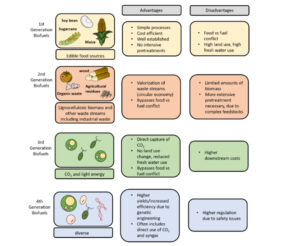Cavelius P, Engelhart-Straub S et all
04/03/2024
Fossil fuels account for more than three-quarters of energy production, releasing enormous amounts of carbon dioxide (CO2) that drive climate change effects as well as contributing to severe air pollution in many countries.
Hence, drastic reduction of CO2 emissions, especially from fossil fuels, is essential to tackle anthropogenic climate change. To reduce CO2 emissions and to cope with the ever-growing demand for energy, it is essential to develop renewable energy sources, of which biofuels will form an important contribution.

Fig 1. Schematic depiction of the different biofuel generations.Illustrations of possible feedstocks are depicted alongside the advantage and disadvantages associated with each generation of biofuel.
In this Essay, liquid biofuels from first to fourth generation are discussed in detail alongside their industrial development and policy implications, with a focus on the transport sector as a complementary solution to other environmentally friendly technologies, such as electric cars.
We laid out the reasoning for biofuel production as immediate and long-term measures to limit and eliminate energy and mobility-related GHG emissions. In that regard, biofuels will not be the only solution but an essential building block in a network with other physical (i.e., wind power, photovoltaic systems) and chemical technologies (i.e., Sabatier process, Power to X) that together can provide carbon neutral or even carbon negative energy and mobility solutions. In regard to transportation, biofuels should act in synergy with other technologies, such as electrified vehicles. In addition to biofuel manufacturing, similar processes could also be implemented in other applications. Here, algal and yeast oil can be transformed into building materials such as carbon fibers and cement additives. Via these routes, atmospheric CO2 can be absorbed from the environment and stored for very long periods of time. Such technologies could complement materials derived from fossil fuels or that generate large amounts of CO2 during the manufacturing process (e.g., steel, aluminum and concrete).
With respect to governments, this means that neither ideology nor demagogically driven decision-making will protect any society from the effects of climate change. There are just no simple answers to complex, global problems. What is needed are global governmental alliances that make technocratically oriented long-sighted decisions, aiming for definitively set climate-centered outcomes even if the communication of the measures that have to be taken may not be popular on first sight.
Even outside the scientific communities, people are ready to accept change of the status quo in order to curb climate change effects and transition to a sustainable society. The question remains if the global political elites are ready to communicate and implement this change.
Time is running out to maintain the global ecosystems as we know it.



